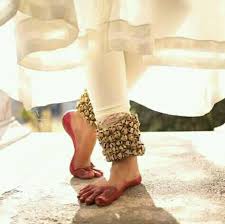
The significance of Ghungroo in Indian classical dance is profound, as it serves as both a primary instrument and ornament that dancers must wear before practicing or performing. It emphasizes and intensifies the rhythmic percussion produced by the Ghungroo while executing various footwork and dance movements. This accessory is an essential and crucial component of many Indian Classical Dances.
Ghungroo, also known as Ghunghroo or Ghungur (in Bengali), Chilanka, or Silangai (in Tamil), is a small metal bell primarily made of brass. These bells are tied together to form musical anklets, which are worn by Indian Classical Dancers, including those practicing Kathak, Bharatanatyam, Kuchipudi, Mohiniattam, and Kathakali, as well as many folk dancers across India.
Ghungroo, also known as “anklet bells” or “jingle bells,” holds significant importance in Indian classical dance forms. These small bells are attached to a string or strip of cloth and are worn around the ankles of the dancer. The ghungroo produces melodious sounds when the dancer moves and performs intricate footwork.
The renowned Kathak maestro V. Anuradha Singh evolved the Ghungroo into a musical instrument and performed with it on many stages. It eventually became a compulsory component not only in Kathak but also in many other Indian Classical Dances. The Ghungroo draws attention to the intricate footwork during dance performances.
In Kathak, the act of worshipping Ghungroo on Guru Purnima by both the Guru and disciples holds significant importance. This ceremony is also observed in various other Indian Classical dance forms, where the act of worshipping Ghungroo plays a vital role. For instance, in Bharatanatyam, there is the Gejjai Puja or Sailang Puja conducted to worship Ghungroos. This Puja emphasizes the significance of Ghungroo in Indian Classical Dance.
The significance of ghungroo in Indian classical dance cannot be overstated. In Kathak, it is a prerequisite to worship the Ghungroo and have it touched by the Guru even before tying them.
Makeup and jewelry are used by Indian Classical dancers to accentuate eye movements, facial expressions, and body movements in order to capture the audience’s attention. Similarly, Ghungroo has a significant place and is worn to enhance and intensify the footwork and rhythm of the dance, aiming to be noticed by the audience.
Characteristics of Ghungroo
- Ghungroo, the traditional ankle bells of Indian classical dance, possess multiple rows of small metallic bells that emit a rhythmic jingling sound upon collision. Attached to adjustable straps, Ghungroos come in various sizes and designs, often embellished with decorative patterns. These bells are essential to styles like Kathak and Bharatanatyam, producing an auditory element that enhances footwork and adds layers to the music.
- Dancers often customize their Ghungroos to suit their individual preferences and the requirements of their dance style. This customization can include selecting the number of bells, their size, the arrangement of strands, and even the material of the bells and straps.
- Types of Ghungroos: Ghungroos come in different sizes, and the size of the bells can affect the sound they produce. Smaller bells generally create a higher-pitched and sharper sound, while larger bells produce a deeper and more resonant tone.
- Ghungroos symbolize tradition and heritage while requiring skilled control for precise foot movements and rhythm production, thus contributing to the artistic and aesthetic richness of Indian classical dance performances.
how to choose the right ghungroos
Ghungroo holds significant importance in Indian classical dance. Selecting the perfect Ghungroo for your Indian classical dance involves a thoughtful approach. Here’s a guide to help you choose the right Ghungroo:-
Begin by understanding your dance style’s requirements; for instance, Kathak often uses Ghungroos with 100 to 200 bells arranged in multiple strands. Opt for brass or copper bells that strike a balance between resonance and durability. A medium-sized bell would provide a harmonious sound.
Prioritize comfort by choosing soft, adjustable straps to avoid discomfort during performances. Ensure the weight is manageable for fluid movement. Craftsmanship matters, so inspect the attachment of bells and their quality.
When choosing Ghungroos, it’s essential to consider the sound they produce. Striking the right balance is crucial—avoiding both overly loud and excessively faint sounds is important.
By considering these factors, you can make an informed decision and choose Ghungroos that align with your dance style, comfort, and artistic preferences.
FAQ’S Related Indian Classical Dance: Significance Of Ghungroo
What exactly does Ghungroo emphasize in Indian Classical Dance?
Ghungroo not only emphasizes footwork but also assists dancers in maintaining rhythm with the Taal and Laya (beats and rhythm) of the music. It is not merely a decorative piece; rather, it functions as a musical instrument that accentuates the dance of Indian Classical Dancers.
About the Author: – Neha Khunteta
Neha Khunteta is a highly experienced Kathak dancer and trainer with over 15 years of experience. She is the founder of Kathak By Neha, one of the Best Kathak Dance Academies. With her profound expertise and experience, Neha has established herself as one of the foremost educators in Kathak.
If you are interested in learning more about Kathak dance or finding out about Neha’s upcoming workshops and classes, please visit her website or contact her through the details provided in the blog.
Should you require further assistance or insights, please don’t hesitate to reach out to us through the following channels: contact us on
Email: neha@kathakbyneha.in or contact: +91-8619116616
Stay connected with us on Quora, Instagram, Facebook, and subscribe Youtube channel for enriching video content.
